Battle banners dopetrovskoy Russia. Victory Banner - The Sign of Ancient Russia
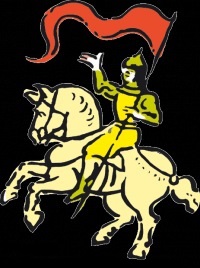
Linkage with a bident 966 - 988
This form of banners was drawn on Arab dirhams of the 10th century. The two-prince was a symbol of the Khazar Kaganate, and when Prince Svyatoslav the Great crushed the Kaganate, he introduced the banners with the images of a two-prince as a symbol of victory over Khazaria.
Scarlet XI - XII century

In the 11th — 12th centuries in Russia there were mostly triangular banners of predominantly red color. There are also yellow, green, white, black banners.
Banner of the "Most Gracious Savior" of the XII - XVI Centuries

Here is one of the oldest Russian banners, which was used by the troops of Alexander Nevsky and Dmitry Donskoy. Preserved only such a constraint.
Great Ivan the Terrible 1550 - 1584
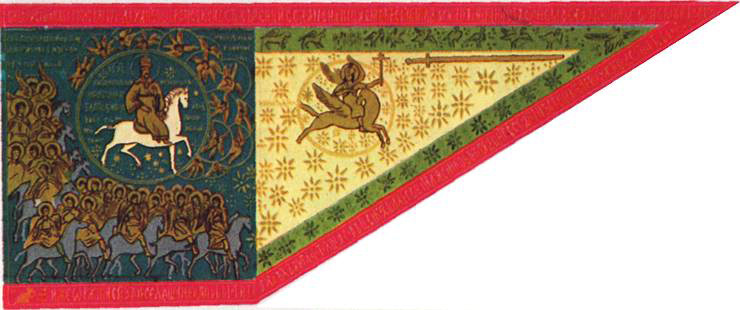
At the flagpole on the azure field, St. Michael is depicted on a horse. On the slope of the "sugar" color depicts Christ. The banner has a cowberry-colored border, and an additional poppy-colored border at the slope. Religious subjects were depicted on other royal banners. On the scarlet banner of Alexei Mikhailovich, for example, depicted the face of the Savior.
Banner Ermak 1581 - 1585
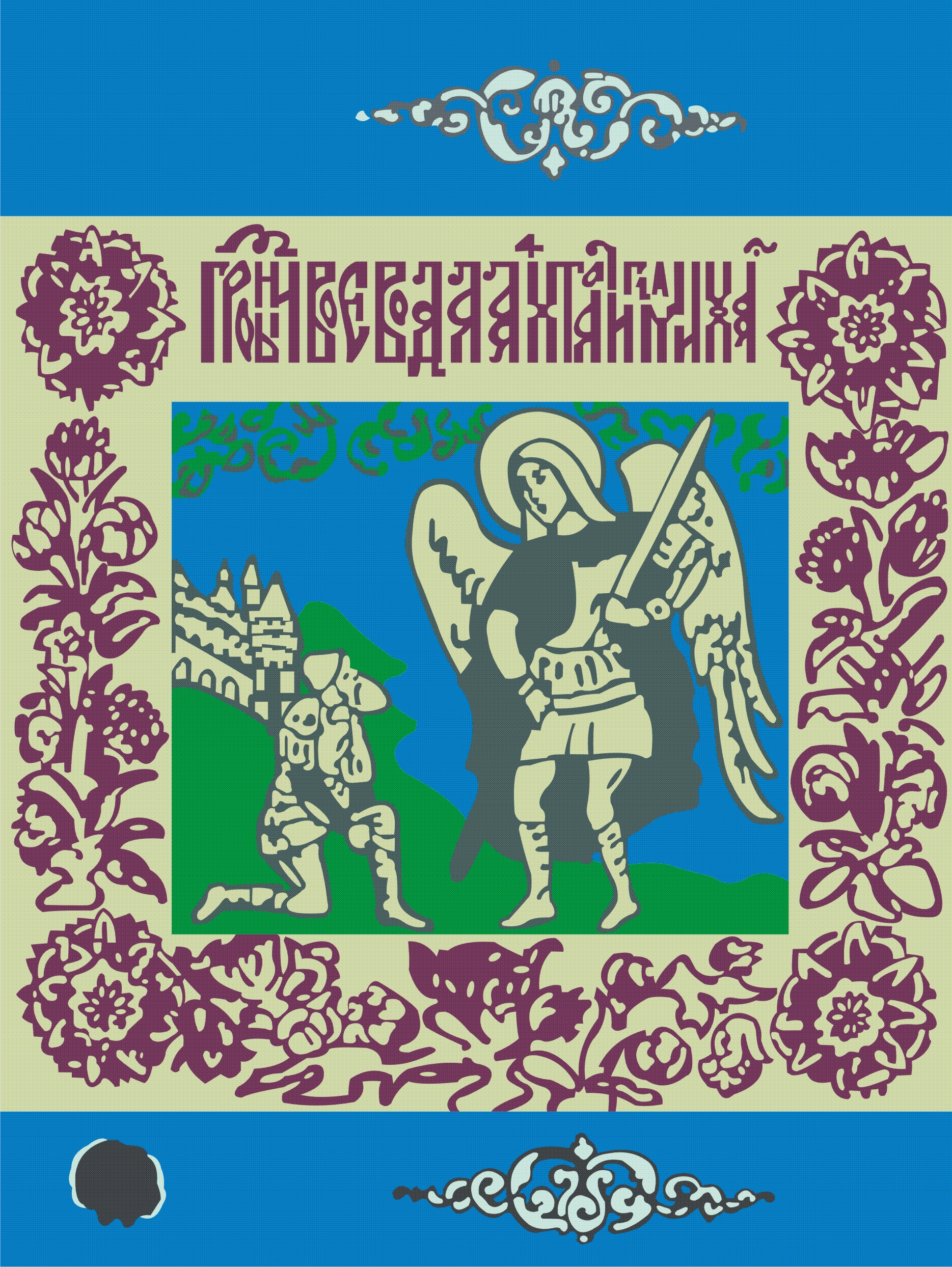
In the collection of relics of the Armory Chamber, there are still three banners of Ermak, "under which he conquered Kuchum's Siberian Khanate in 1582". The cloth has a length of more than 2 meters, one of which embroidered images of Joshua and St.. Michael (the plot of the image - a scene from the Old Testament), on the other two - a lion and a unicorn, ready for battle.
The banner of Dmitry Pozharsky 1609 - 1612
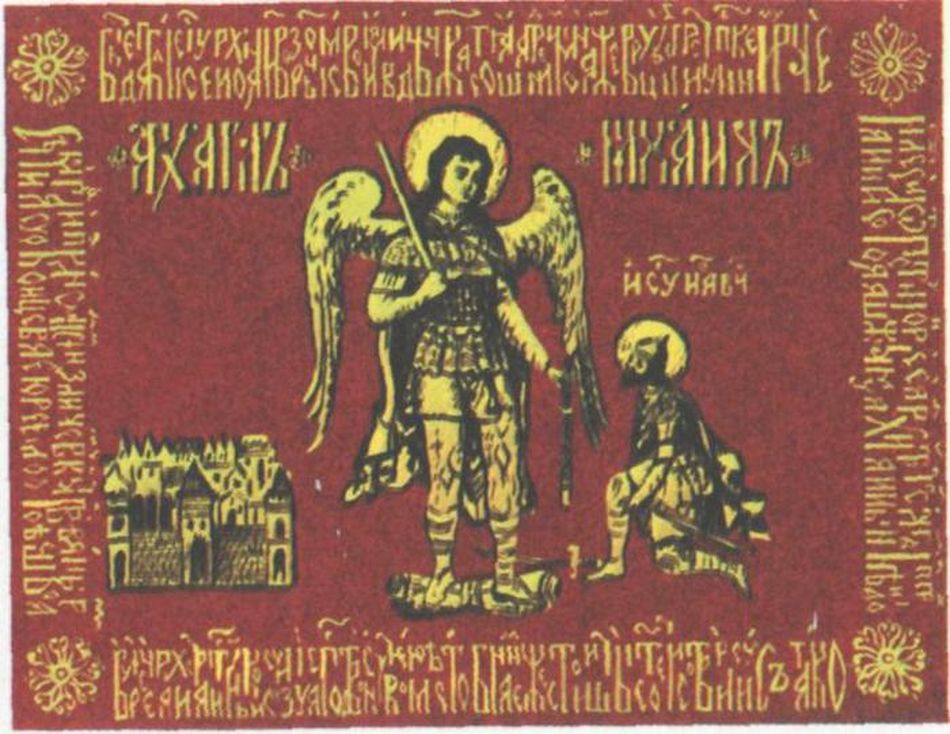
The banner was used by Dmitry Pozharsky and Kuzma Minin in the Second Militia.
Banner of the Big Regiment 1654 - 1701
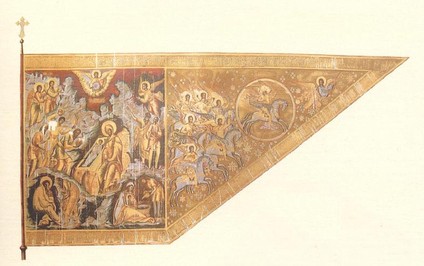
This banner was used exclusively in the Big Regiment from 1654 to 1701. Canceled by Peter I.
The coat of arms of Alexei Mikhailovich 1668 - 1696
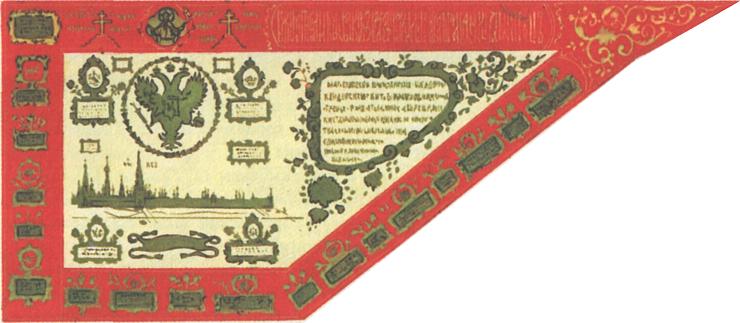
This is the first emblem of Russia, established by Tsar Alexei Mikhailovich in 1668, together with the first Russian flag (see below). The coat of arms was white with a wide red border, in the center was depicted a golden double-headed eagle and coat of arms subject to the king of the land, on the border was a legend.
Flag of the Russian Kingdom (XVII century) 1668 - 1696
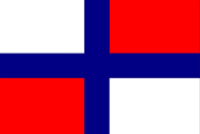
The very first state flag of Russia. Approved by Alexei Mikhailovich, as the flag of the first Russian commercial court "Eagle".
Flag of the Tsar of Moscow 1693 - 1720
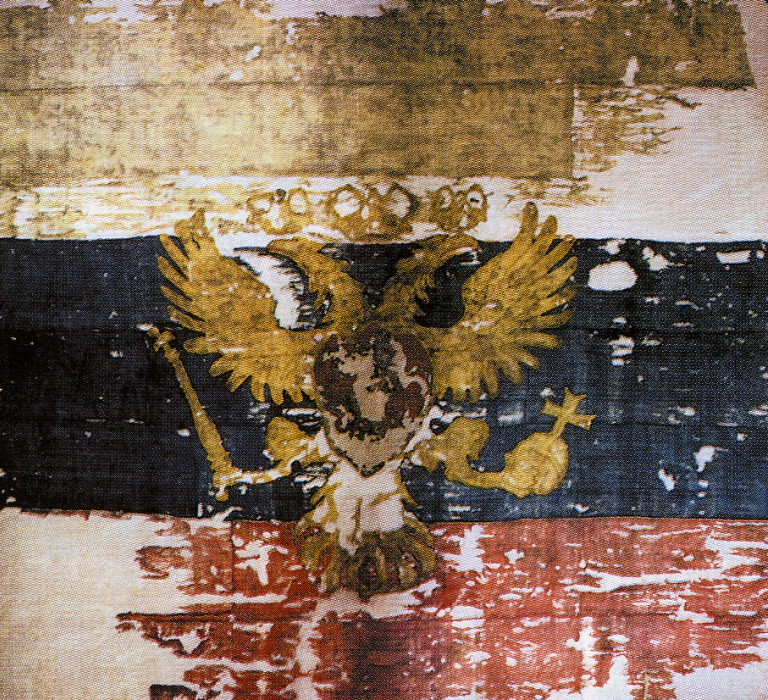
The flag began to be used by Peter I in 1693. The king ordered to refer this flag to all former kings of Moscow. It depicts the Russian tricolor and the coat of arms of Russia of the XVII century.
Trade Flag of Russia 1705 - 1917

The tricolor, introduced by Peter I as part of the standard of the Moscow Tsar and the flag of the Army, became the ship’s flag of Russia in 1705 and was used until 1917.
Shtandart Russian or Tsarsky
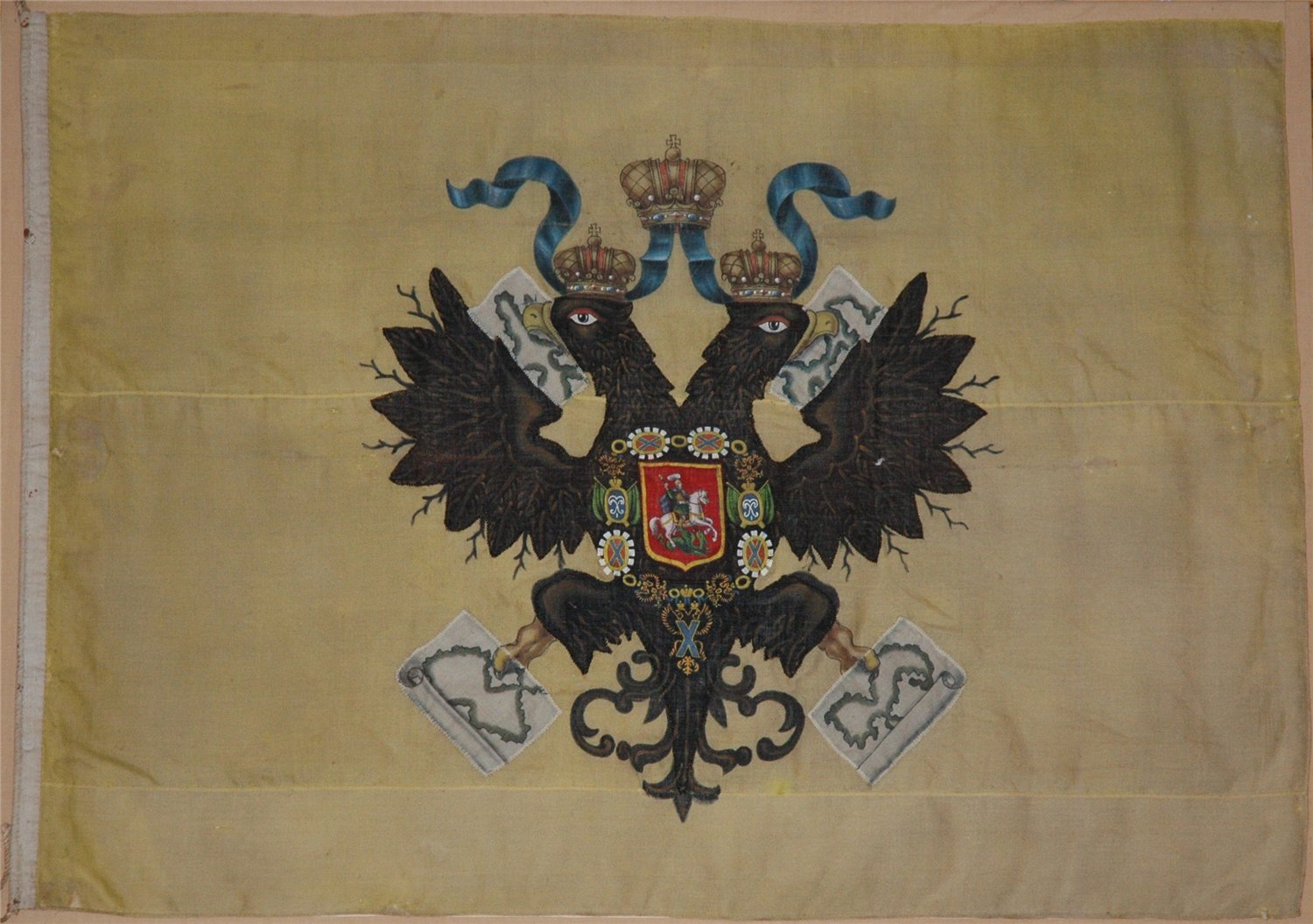
State banner of the Russian Empire 1742−1858

In 1742, in connection with the forthcoming coronation of Empress Elizabeth Petrovna, the state banner of the Russian Empire was made, which became one of the insignias and was used at ceremonies, coronations, and burials of emperors. It consisted of a yellow cloth with a black-headed eagle on both sides, surrounded by oval shields with 31 arms, symbolizing the kingdom, the principality and the land mentioned in the imperial titulature.
State (coat of arms) flag 1858
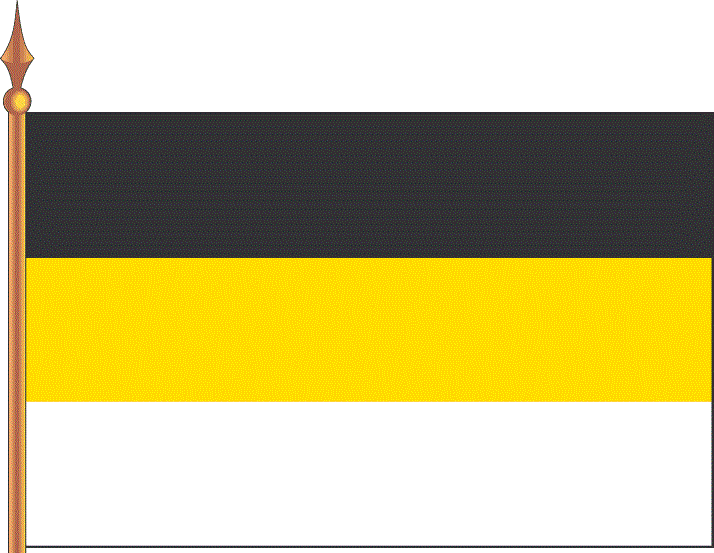
By the decree of Alexander II of June 11, 1858, a black-yellow-white “coat of arms” was introduced. The flag consists of three horizontal stripes: black, yellow (gold) and white.
Russian national flag 1883
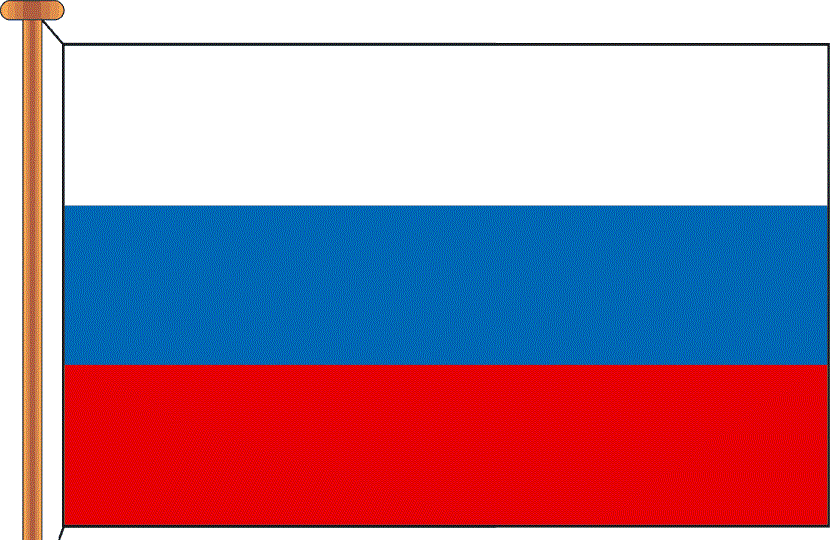
During the second half of the 19th century, among historians there were debates about which flag to consider as national: white-blue-red or black-yellow-white. The issue was officially resolved on April 28, 1883, when Alexander III ordered the use of an exclusively white-blue-red flag. Black, yellow and white remained only in the imperial family.
State national flag of 1914

In 1914, a new national white-blue-red flag was added with a special circular from the Ministry of Foreign Affairs, with a double-headed eagle added at the top of a yellow square.
Flag of Republican Russia 1917

According to the decision of the Legal Conference in April 1917: "The white-blue-red flag, since it does not carry the attributes of any dynastic emblems, can be considered the flag of the new Russia."
USSR flag 1924
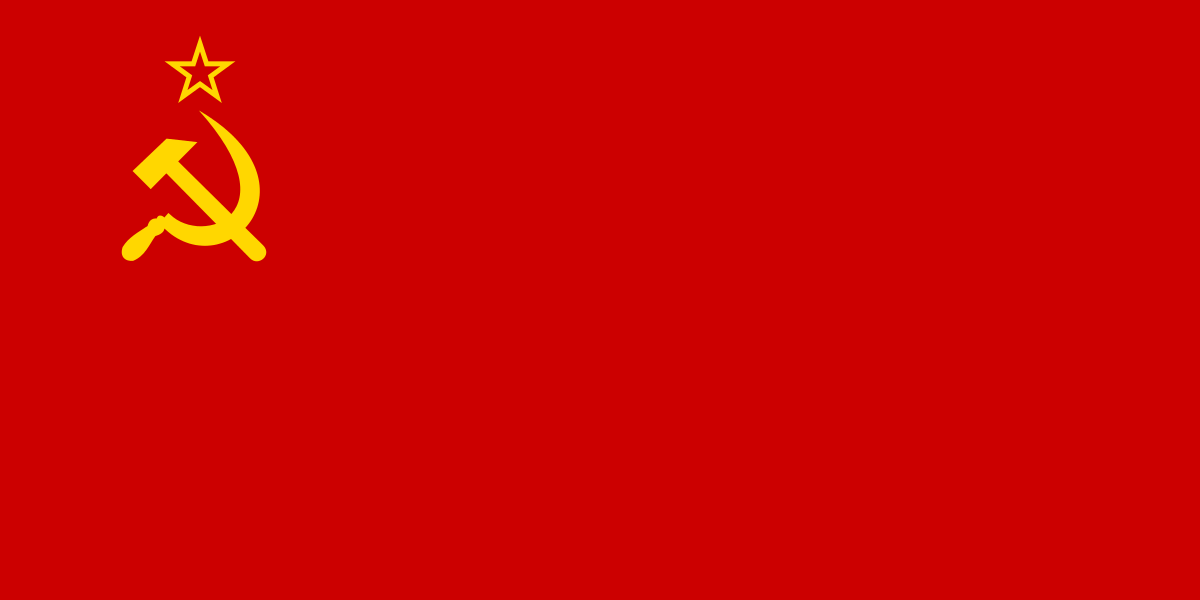
The flag was a red rectangular cloth with an image in the upper corner, near the pole, gold sickle and hammer and above them a red five-pointed star framed by a gold border. He was "a symbol of the state sovereignty of the USSR and the inviolable union of workers and peasants in the struggle to build a communist society." The red color of the flag — the symbol of the heroic struggle of the Soviet people for building socialism and communism; the hammer and sickle signify the unshakable alliance of the working class and the collective-farm peasantry. The red five-pointed star on the flag of the USSR is a symbol of the ultimate triumph of the ideas of communism on the five continents of the globe.
Flag of the RSFSR 1991 - 1993
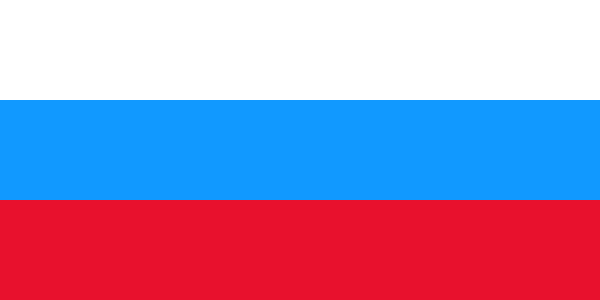
State flag RSFSR from November 1, 1991. He remained the national flag until December 11, 1993.
Flag of Russia 1993 - present

Official state symbol Russian Federation, along with the coat of arms and anthem. It is a rectangular panel of three equally-sized horizontal stripes: the top is white, the middle is blue, and the bottom is red. The flag colors are attributed with many symbolic meanings, but there is no official interpretation of the colors of the State Flag of the Russian Federation. The most popular decoding is as follows:
White color symbolizes nobility and frankness;
Blue color - loyalty, honesty, perfection and chastity;
Red is courage, courage, generosity and love.
Abuse of the State Flag of the Russian Federation is a crime.
| Categories: | alien / repost / from the Internet |
In Russia, flags and banners were called banners, since the army was attached to them. Under Ivan the Terrible, the banners could reach three meters in length. We recall the banners under which we went to battle in the pre-Petrine times.
Traditional for Russia - red. For many centuries, the squads fought under the banners of the wedge-shaped form, with tops in the form of a spear with a crossbar, that is, in the form of a cross. Svyatoslav the Great, Dmitry Donskoy, Ivan the Terrible led the troops under the red flags.
The naive version is that there were no flags in Russia until the second half of the 17th century, and the Dutch invented them. About the first flags in Russia, we get information already from the chronicle "The Tale of Bygone Years".
1. Russian Banner

In Russia, instead of the words “flag” and “banner” the word “banner” was used, since under him the army. The flag marked the middle of a huge army. He was guarded by warriors - styagovniki. From afar, it was clear whether the squad suffered defeat (the lanes fell) or the battle was successful (the banner “stretched like clouds”). The shape of the rod was not rectangular, but in the form of a trapezium. The banner of the banner could be with three, two, but more often with one triangular wedge of matter.
As a rule, the princely army had several military banners, which it was necessary to assemble under a sound signal. Sound signals were given by pipes and tambourines. The chronicle story about the Lipitsk battle of 1216 states that Prince Yury Vsevolodovich had “17 banners and 40 pipes, as many tambourines”, his brother Prince Yaroslav Vsevolodovich had “13 banners, and pipes and tambourines 60”.
Ill. Siege of Korsun (Chersonesos) by the army of Prince Vladimir. Miniature from the Radziwill Chronicle
2. Russian Gonfalon
In the XII century, in the famous "Lay of Igor's Regiment," one more designation of the military banner is mentioned - banner. The banner is not a means of controlling the army, but a symbol of the state, of power. Now, victory is marked by hoisting the banners on the city walls and gates of the enemy.
From the descriptions of the banners given in “The Tale of the Mamai Massacre”, it follows that the saints were depicted on Russian military flags, which were hardly mentioned in the earlier period. Before one of these banners, starting the battle, Prince Dmitry Ivanovich Donskoy fell to his knees to pray for victory over the Tatars.
In the "Tale" it is described very figuratively: "The great prince, seeing his shelves decently arranged, got off his horse and fell on his knees right in front of a large regiment with a black banner on which the image of the Lord of our Lord Jesus Christ was embroidered and from the depths of the soul began to cry out loud "... After the prayer in front of the banner, the grand prince rode over the regiments, turning to the Russian soldiers with a heartfelt speech, in which he called" without confusion, "to stand firmly behind the Russian land.
Ill. Boris goes to the Pechenegs. Thumbnail from Silvestrovsky collection. XIV century.
3. Russian flag
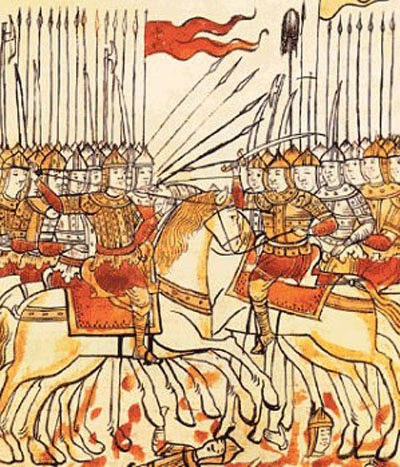
The banner comes from the word "sign", these are banners with the image of Orthodox figures - George, Christ, the Virgin Mary. Since ancient times, the grand dukes went on campaigns under such banners. The feudal lords of Western Europe carried personal emblems on their banners, the emblems of the ruling clans were quite secular symbolic signs. Russia turned to God, to the Most Holy Theotokos, to the patron saints - “assistants in the army”, because it was thanks to Orthodoxy that the Russians managed to resist the centuries-old foreign yoke. Similar appeals to heavenly patrons, the intercessors of the Russian land, also carried banners accompanying the Russian princes in their military campaigns. And the image of the Most Gracious Savior, for example, on the banner of Dmitry Donskoy is not accidental.
Ill. Battle of Kulikovo field. Miniature. XVI century.
4. Joshua on the banner
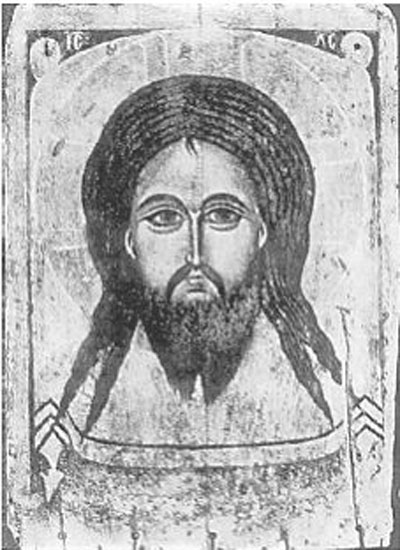
The white banner of the Grand Duke of Moscow Vasily III, father of Ivan the Terrible, depicted the biblical commander Joshua. One hundred years later, Joshua appeared on a crimson cloth of the banner of Prince Dmitry Pozharsky, which is kept in the Armory. It is rectangular, two-sided: on one side is the Almighty - Jesus Christ, whose right hand is in a gesture of blessing, the left holds the Gospel. The image is bordered by texts of Scripture. On the reverse side of the banner, Joshua bowed his knees before Archangel Michael, the archangel of the heavenly host, and the inscription on the edge of the banner explains the meaning of the biblical story.
Ill. "Savior, not made by hands". The icon is a banner. XIV century.
5. Great Banner Ivan the Terrible
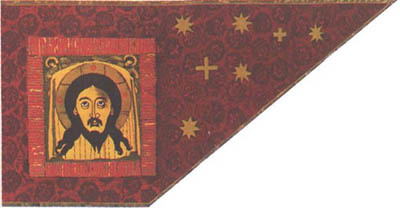
Under Ivan the Terrible, the attitude towards flags became not only respectful, but sacred. Behind each of them stood a story, victories, feats and lives. They were told about them "with that banner the Tsar and the Grand Duke of All Russia subjugated the Kazan Khanate to the Russian state and defeated numerous Basurmanian peoples." Flags were created from expensive fabrics, with artful embroidery in gold or silver on silk. Often the banner was trimmed with a border or fringe. The flags of Ivan the Terrible reached a length of 3 meters, in height - 1.5. To carry the banner were appointed two or three people. The lower end of the shaft of such a banner was sharp, so that the banner could be stuck into the ground.
Description of the Great Banner Ivna IV: “Built” is from a Chinese taffeta with a single slope. The middle is azure (light blue), the slope is sugar (white), the border around the cowberry-colored cloth, and around the escarpment - poppy. A circle of dark blue taffeta is sewn into the azure middle, and in the circle - an image of the Savior in white clothes, on a white horse. Along the circumference of the circle are golden cherubim and seraphim, to the left of the circle and under it are the heavenly host in white robes, on white horses. A circle of white taffeta is sewn in the slope, and in the circle is the holy Archangel Michael on a golden winged horse, holding a sword in his right hand, and a cross in his left. Both the middle and the escarpment are covered with gold stars and crosses.
Under this banner in 1552, the Russian regiments marched beneath him on the victorious assault of Kazan. In the chronicle entry about the siege of Kazan by Ivan the Terrible (1552) it says: "and the sovereign Herugwy ordered the deployment of the Christian, that is, the banner, on them the image of our Lord Jesus Christ, without hands," This flag and a half century was accompanied by the Russian army. Under Tsarina Sofia Alekseevna, it was in the Crimean campaigns, and under Peter I - in the Azov campaign and at war with the Swedes. there was a banner.
6. Banners according to the rank of holy icons

In the seventeenth century. The father of Peter the Great, Tsar Alexei Mikhailovich, went to Smolensk, Vilna and Riga under a large banner of crimson-colored taffeta with the face of Jesus Christ on it. The banner is a real work of art, executed with the finest embroidery, and the image of the Savior is expressively close to icon painting. Great honors were given to these banners. They were consecrated by the patriarch according to the rank of holy icons.
Ill. Neva battle. Fragment of the picture. Hood A. Kivshenko
7. First State Flag
In the picture: The squad of Oleg Oleg storming Constantinople under the red banner.
The first flag of Russia was a red flag. Under the red cloth, the campaigns of Gostomysl, Oleg the Wise and Svyatoslav went on campaigns. The flag under which Svyatoslav smashed the Khazars had on him an image of a bident. With the adoption of Christianity, the two-prong was replaced by a cross on Calvary. During the period of feudal fragmentation, each principality had its own flag. The first attempt to introduce the All-Russian flag was a banner with the face of Christ. Under this flag, Dmitry Donskoy won the Battle of Kulikovo.
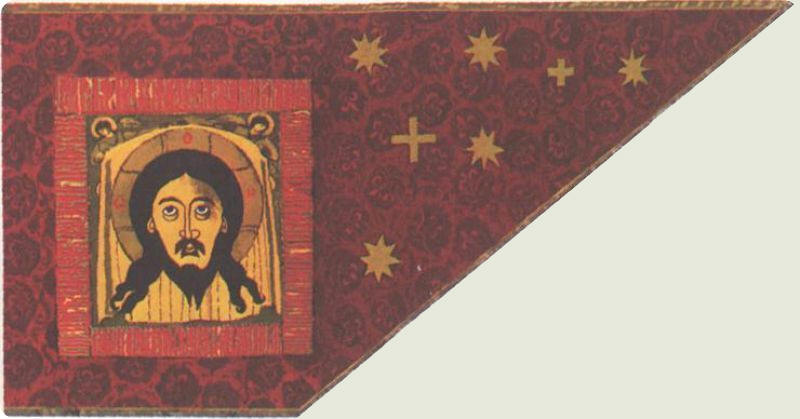
In Ancient Rus, banners could be of different shapes. Spreads in the form of an elongated triangle were spread. There were also spread-wounded banners with long shoots sewn to them - braids (or trunks), which fluttered in the wind, creating a special mood.
The red flag of the Slavs from ancient times was fanned by military glory and military prowess in the defense of the Russian Land against invasions by invaders. Alexander Nevsky, Dmitry Donskoy fought with the enemies of Russia under the red banner. For a long time, the Slavs "red color" symbolized the beauty of the Universal Light, which in the mythology of the Slavs manifested itself in the image of the Solar Energy Yaryla. One of the images of Yarila (the Sun) was the name of Kolyada (Khors). Horse (the baby - the Sun) was responsible in Russia for the sunny (good) mood, which was supposed to be present at all the holidays. It was not by chance that a red shirt, a red caftan, and a red sundress were considered festive colors.
Thus, the red color was not only the color of the sun and beauty. It was the color of truth and justice, the color of the righteous life of the Slavs. With the beginning of the planting of serfdom in Russia, the flag is changed. At the same time, not only the symbolism of the Byzantine power, but the immoral way of life of exploiting one another, is adopted in the West.
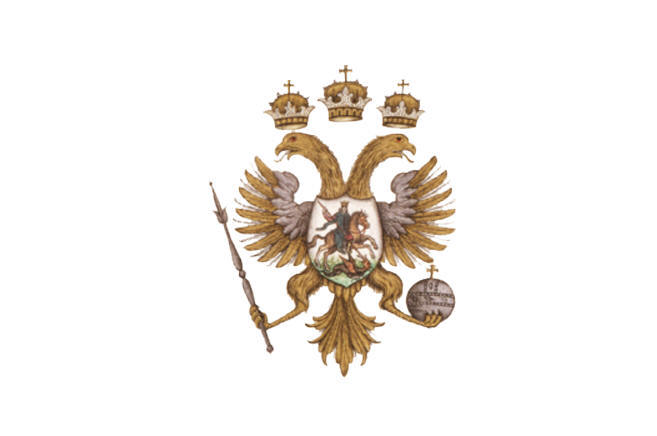
The double-headed eagle on a white background is a symbol of Byzantine power.
For the first time the white-blue-red flag was raised on the first Russian military ship "Eagle", launched in 1667 by Peter I. It is noteworthy that the Russian fleet under the tricolor (white-blue-red flag) was defeated by the Swedes. Russia under this state symbol suffered a defeat in the Russian-Swedish (Northern) War. Only with the refusal of the failed state symbol in the form of a white-blue-red flag, the situation in the military field has changed for the better.
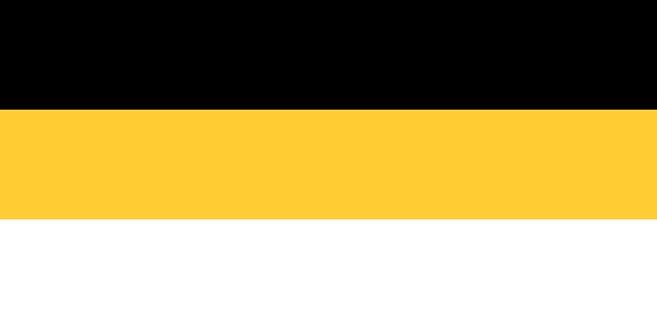
From this point on, the white-blue-red flag is transferred to the jurisdiction of the Russian merchant fleet. And as such, this symbol until February 1917. Peter I had long been looking for his symbol for Russia in the form of the flag of the Russian Empire. And in the end, the choice stops on a black-yellow-white flag, which existed until the February bourgeois revolution, paid for by the big capital of England. From this moment on, the Social Revolutionaries, who sold themselves to English bankers, return the white-blue-red flag to Russia as the state symbol. By a strange coincidence, big troubles are raining down in Russia in the form of famine and complete socio-economic disruption. The country was on the verge of complete ruin and redistribution of territory by the Western powers. The Bolsheviks intervened in the situation of anarchy, who choose the ancient symbol of the Slavs (the Red flag) as their symbol.

Under the revived symbol of Russia, the RSDLP (b) party is trying to lead the country out of the socio-economic crisis. The basis of appeals V.I. Ulyanov (Lenin) are the foundations of the veche democracy. The essence of this revival are the Soviets of People’s and Soldiers' Deputies. At the heart of the socialist construction put ancient symbols of the power of the Slavs - "Truth - Justice - Loyalty", "Equality - Freedom - Brotherhood". Under this flag, the RSA of the RSFSR defeated the imperialists and the Socialist-Revolutionaries, who received funding from England through American banks.
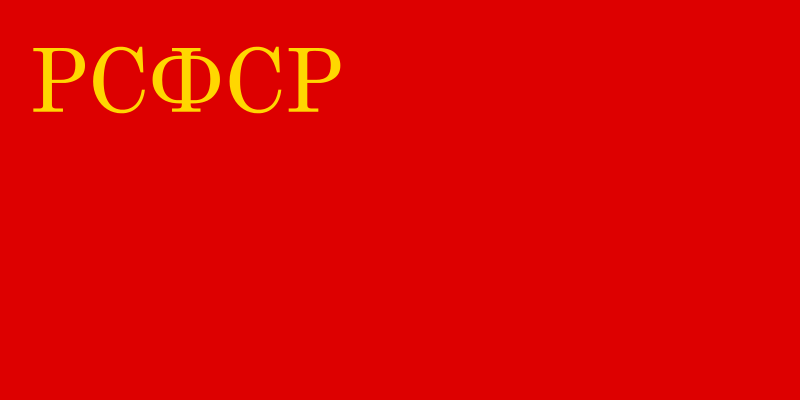
By a decree of the Presidium of the All-Russian Central Executive Committee of April 1, 1937, a new sample of the image of the national flag of the RSFSR was developed, designed on behalf of the Presidium of the All-Russian Central Executive Committee by artist A. Milkin. In contrast to the flag of the RSFSR of the previous model, the new flag did not have a roof circled with gold lines, and the abbreviation of the name of the republic was applied in normal type, without dividing points.
On January 20, 1947, the Presidium of the Supreme Soviet of the USSR, by its decree “On the State Flags of the Union Republics”, recognized it expedient to make changes in the national flags of the Union SSRs so that the state flags of the Union SSRs reflect the idea of a union Soviet state and the national characteristics of the republics. The emblem of the USSR was placed on the flags — a sickle and a hammer with a red five-pointed star, while maintaining the basic red color of the cloth, and other colors were introduced in addition to the main red color, the national ornament was included. By decree of the Presidium of the Supreme Soviet of the RSFSR of January 9, 1954, a new description of the state flag of the RSFSR was established: a red rectangular cloth with a light blue stripe at the flagpole in the full width of the flag, which is one-eighth of the flag's length. In the upper left corner of the red cloth were depicted golden sickle and hammer, and above them a red five-pointed star, framed by a golden border.

The red flag at all times on the Russian Land was a symbol of Victory. And it seems not by chance that the greatest battle on a world scale was held under his symbol. The peoples of the USSR survived in the fight against fascism and the Red Banner of the USSR became a symbol of the Great Victory on May 9, 1945.
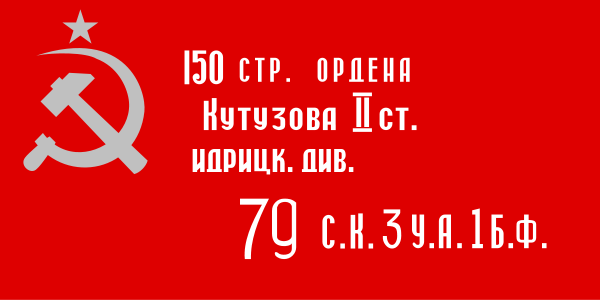
Whether historical justice will prevail in relation to the most ancient symbol of Russia - a symbol of victory over the enemies of Russia, a symbol of beauty and spilled blood on the battlefields, time will tell ...
Flag of Ancient Rus In ancient times, the word "flag" was used instead of the words "flag" and "banner". The expression "put a banner" meant the construction of the squad to the battle. In ancient times, the word "flag" was used instead of the words "flag" and "banner". The expression "put a banner" meant the construction of the squad to the battle. The origin of the word "banner" is also remarkable. Images of Orthodox shrines were called "signs." Once on the banners began to portray of St. George and other holy faces, they turned into "signs," and then into "signs." The origin of the word "banner" is also remarkable. Images of Orthodox shrines were called "signs." Once on the banners began to portray of St. George and other holy faces, they turned into "signs," and then into "signs."
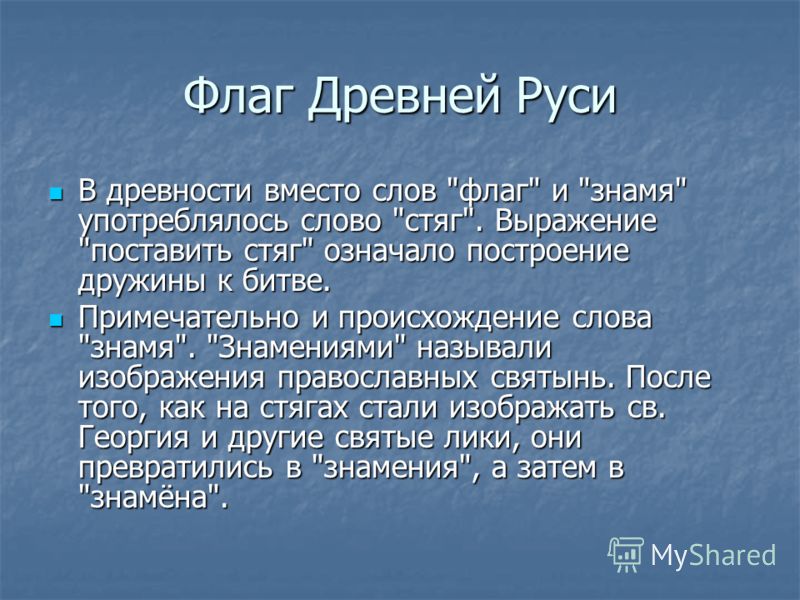
The flags of the Russian squads of the X-XII centuries In form, some of the grand princely banners to 988 AD were three-tailed or with a three-step neckline at the end. This form of banners together with the "bident" - the emblem of the Grand Duke Svyatoslav. In form, some of the grand princely banners to 988 AD were three-tailed or with a three-step neckline at the end. This form of banners together with the "bident" - the emblem of the Grand Duke Svyatoslav.
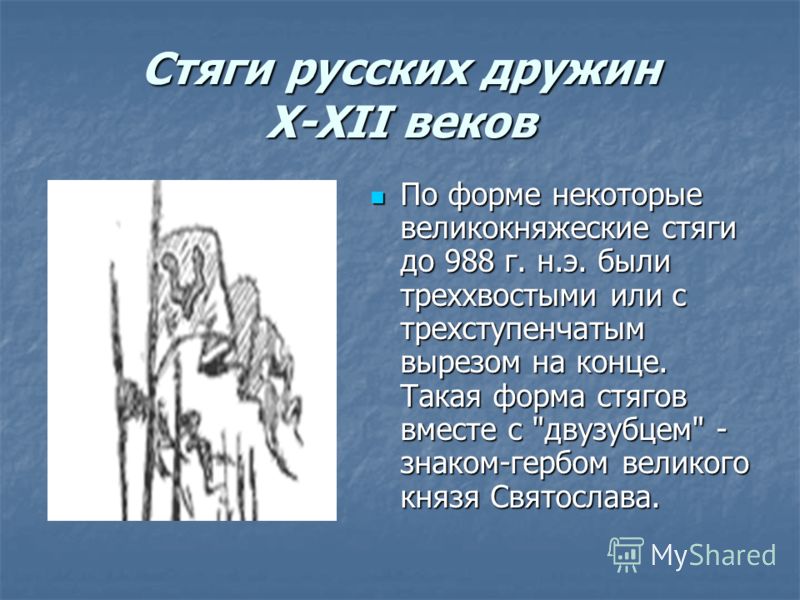
The banners of the Russian squads of the X-XII centuries. Judging by the pictures of the chronicles and the text “The words about Igor's regiment” in the XI-XII centuries in Russia there were mostly triangular banners of mostly red color, although there are yellow, green, white, black flags. Judging by the pictures of the chronicles and the text "Words about Igor's regiment" in the XI-XII centuries in Russia there were mostly triangular banners of predominantly red color, although there are yellow, green, white, black banners.

Banners of Russian squads of the XII-XIV centuries In the XII-XIII centuries. on the banners appears the image of the cross (the cross on Calvary). In the XII-XIII centuries. on the banners appears the image of the cross (the cross on Calvary). This drawing by A.G. Silaev from the icon is blessed by the army of the King of Heaven "(fragment" Battle of Novgorod and Suzdalians) Novgorod, XV century. This drawing by A.G. Silaev from the icon is blessed by the army of the King of Heaven "(fragment" Battle of Novgorod and Suzdalians) Novgorod, XV century.
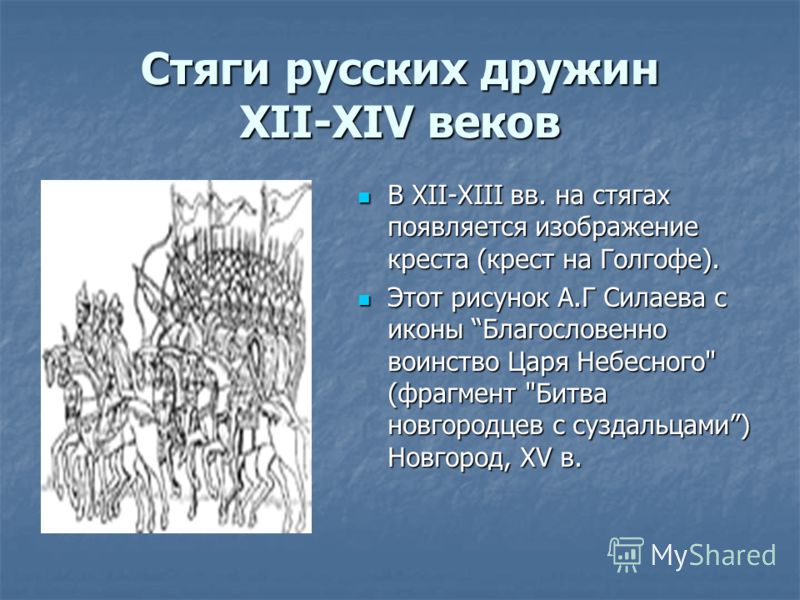
The Great Banner of Ivan the Terrible 1560 This is the Great Banner of Ivan the Terrible. This panel is in the form of a trapezoid (with a slope). At the flagpole on the azure field, St. Michael is depicted on a horse. On the slope of the "sugar" color depicts Christ. The banner has a "cowberry-colored" border, in addition to the slope there is an additional border of "poppy" color. This is the Great Banner of Ivan the Terrible. This panel is in the form of a trapezoid (with a slope). At the flagpole on the azure field, St. Michael is depicted on a horse. On the slope of the "sugar" color depicts Christ. The banner has a "cowberry-colored" border, in addition to the slope there is an additional border of "poppy" color.
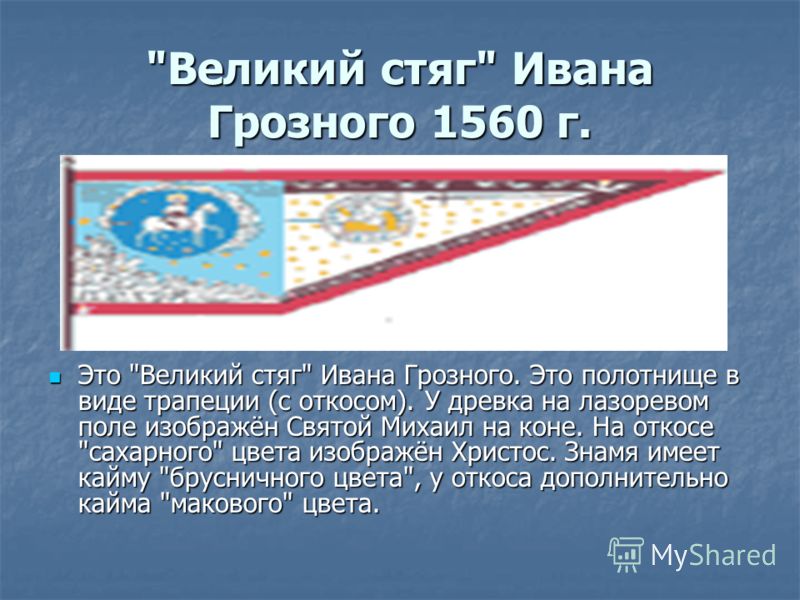
Coats of arms of Alexei Mikhailovich The first such banner was white with a wide red border, in the center was depicted a golden double-headed eagle and coat of arms subject to the king of the land, a legend was placed on the border (author of the coat of arms Stanislav Loputsky). The first such banner was white with a wide red border, in the center was depicted a golden double-headed eagle and coat of arms subject to the king of the land, a legend was placed on the border (the author of the coat of arms Stanislav Loputsky).
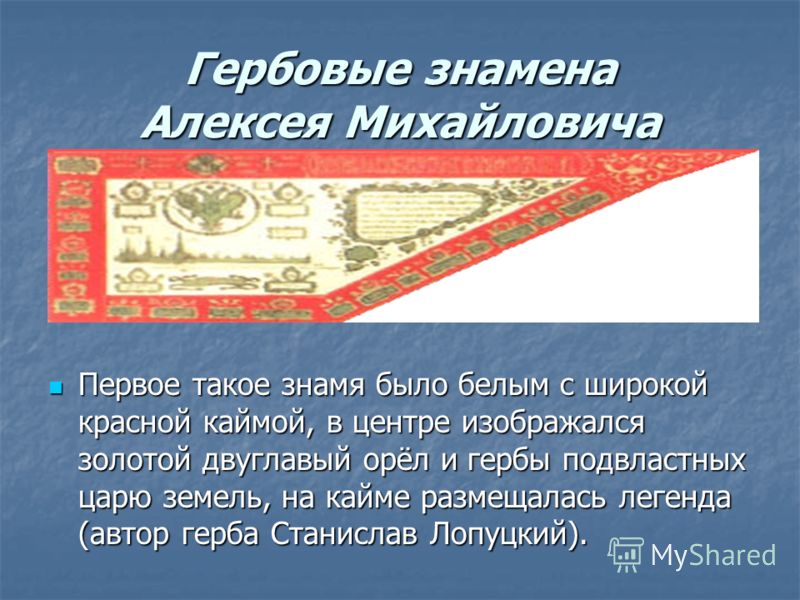
The first banner for the future of the Russian fleet! Created by decree of Tsar Alexei Mikhailovich in the 60s of the XVII century for the first military ship, which was called the "Eagle"; Created by decree of Tsar Alexei Mikhailovich in the 60s of the XVII century for the first military ship, which was called the "Eagle"; The flag had a blue straight cross dividing the cloth into four equal parts of the kryzhi. The first and fourth were white, the second and third were red. The flag had a blue straight cross dividing the cloth into four equal parts of the kryzhi. The first and fourth were white, the second and third were red.
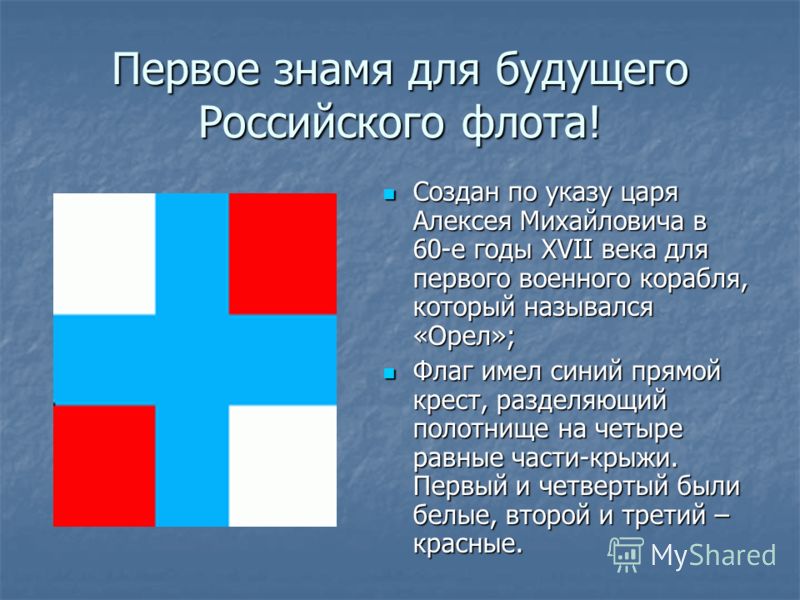
Emblem of Peter I of 1696 One of the first banners of Peter I of 1696, in the traditions of the ancestors. One of the first banners of Peter I of 1696, in the traditions of the ancestors. The red coat of arms with a white border, in the center was depicted a golden eagle soaring above the sea, on the chest of an eagle in the circle of the Savior, next to Saints Peter and Paul, the Holy Spirit. But this banner was not destined to exist for a long time. The red coat of arms with a white border, in the center was depicted a golden eagle soaring above the sea, on the chest of an eagle in the circle of the Savior, next to Saints Peter and Paul, the Holy Spirit. But this banner was not destined to exist for a long time.
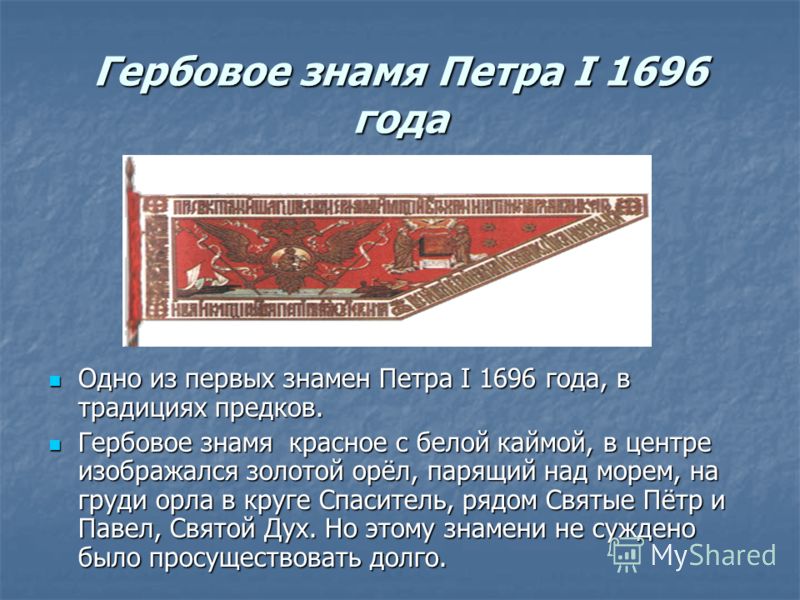
Sketches of flags of Tsar Peter Alekseevich! Peter wanted to create a simple flag, not weighed; Peter wanted to create a simple flag, not weighed; Such a flag appeared in 1693 and was named the flag of the Tsar of Moscow. Such a flag appeared in 1693 and was named the flag of the Tsar of Moscow.
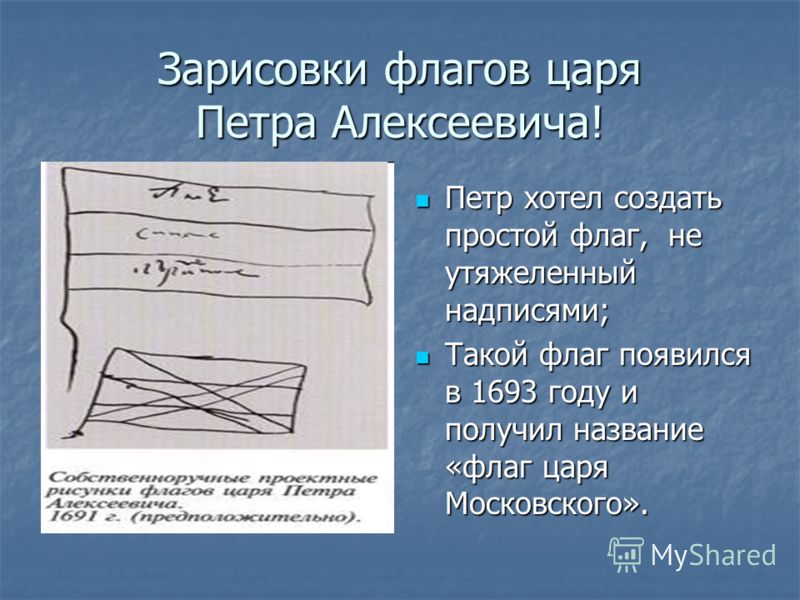
Flag of the Tsar of Moscow The Flag of the Tsar of Moscow was divided into three horizontal stripes: the top one is white, the middle one is blue and the bottom one is red. In the center of the flag there was a yellow double-headed eagle crowned with three crowns with a scepter and a orb. "The flag of the Tsar of Moscow" is divided into three horizontal stripes: the top one is white, the middle one is blue, and the bottom one is red. In the center of the flag there was a yellow double-headed eagle crowned with three crowns with a scepter and a orb.

The first appearance of the flag of St. Andrew In 1698, the first version of the flag of St. Andrew appeared. On the large white field, which was torn from the top and bottom by white-blue-red borders, a blue St. Andrew’s cross was inflicted. This was the first appearance of the symbol of the patron of Russia, Andrew the First Called russian flag. In 1698, the first version of the St. Andrew’s flag appeared. On the large white field, which was torn from the top and bottom by white-blue-red borders, a blue St. Andrew’s cross was inflicted. This was the first appearance of the symbol of the patron saint of Russia, Andrew the First Called, on the Russian flag. White-blue-red was, perhaps, the most famous heraldic invention of Peter the Great. White-blue-red was, perhaps, the most famous heraldic invention of Peter the Great.
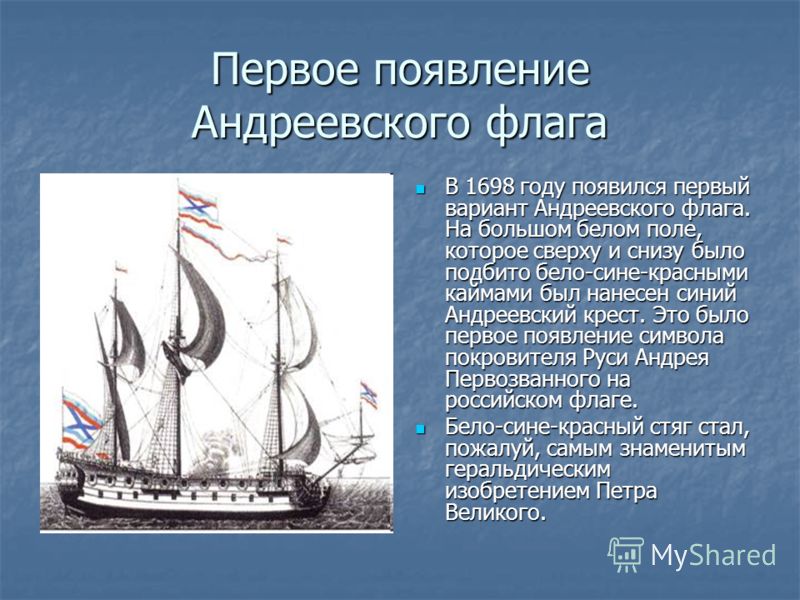
St. Andrew's flag In 1712, a new “Andreevsky” flag was hoisted over naval ships, the white flag with an azure cross, in honor of the Order of St. Andrew the First-Called. In 1712, a new “Andreevsky” flag flew over the naval ships, a white flag with an azure cross, in honor of the Order of St. Andrew the First-Called. The Apostle Andrew the First Called was crucified on an oblique cross. For this reason, in Christians the oblique cross is associated with the name of this apostle. The Apostle Andrew the First Called was crucified on an oblique cross. For this reason, in Christians the oblique cross is associated with the name of this apostle.
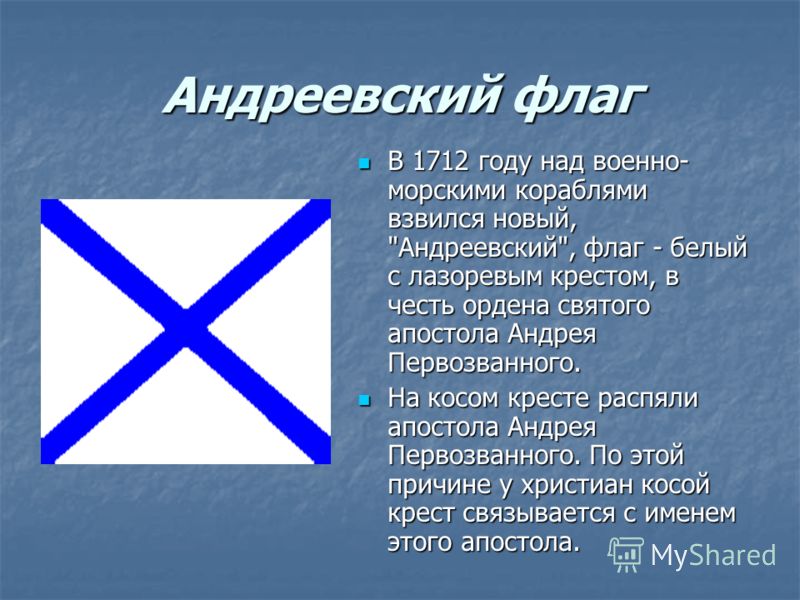
The national flag of Alexander II. By the decree of Alexander II of June 11, 1858, a "coat of arms" was introduced. By decree of Alexander II of June 11, 1858, a "coat of arms" was introduced. The black-yellow-white flag is based on the Russian heraldic tradition. Its black color is from the double-headed eagle, yellow is from the golden field of the coat of arms, and white is the color of St. George Also, its colors symbolized the earth-gold-silver. The black-yellow-white flag is based on the Russian heraldic tradition. Its black color is from the double-headed eagle, yellow is from the golden field of the coat of arms, and white is the color of St. George Also, its colors symbolized the earth-gold-silver.

The approval of the state flag by Alexander III on April 28, 1883 (on May 7, 1883, Alexander III, after “the command of flags to decorate buildings for solemn occasions”, after long hesitations, ordered to use exclusively the white-blue-red flag. April 28, 1883 (May 7, 1883 Alexander III, after the hesitation, ordered the use of the flag of the flag to decorate buildings for solemn occasions, and used exclusively the white-blue-red flag. It was finally declared nationally on April 20, 1896 by Nicholas II. m it was announced April 20, 1896 Nicholas II.

The national national flag of 1914. In 1914, a special national circular of the Ministry of Foreign Affairs introduced "for use in private life" a new national white-blue-red flag with a yellow square with a black two-headed eagle added at the top of the shaft. In 1914, a special national circular of the Ministry of Foreign Affairs introduced "for use in private life" a new national white-blue-red flag with a yellow square with a black double-headed eagle added at the top of the shaft. The new flag was not introduced as mandatory, its use is only "allowed". The new flag was not introduced as mandatory, its use is only "allowed".
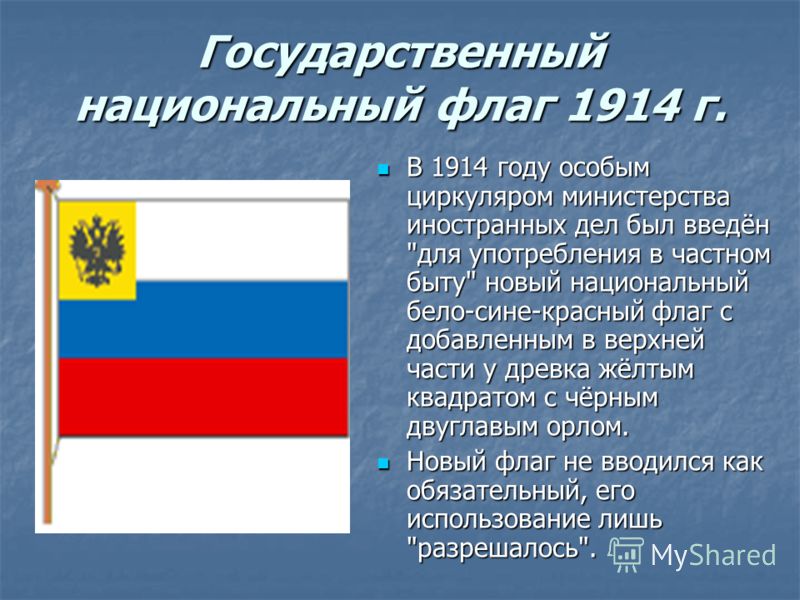
Flag of Republican Russia of 1917. The decision of the Legal Conference in April 1917: "The white-blue-red flag, since it does not carry the attributes of any dynastic emblems, can be considered the flag of the new Russia." The decision of the Legal Conference in April 1917: "The white-blue-red flag, since it carries no attributes of any dynastic emblems, can be considered the flag of the new Russia."

The national flag of the RSFSR of 1918. The flag of the Russian Socialist Federative Soviet Republic consists of a red (scarlet) cloth, in the left corner of which is at the shaft, on top are the golden letters of the RSFSR or the inscription: Russian Socialist Federative Soviet Republic. The flag of the Russian Socialist Federative Soviet Republic consists of a cloth of red (scarlet) color, in the left corner of which is near the hoist, at the top are the golden letters of the RSFSR or the inscription: Russian Socialist Federative Soviet Republic. Date adopted: city Date adopted: city
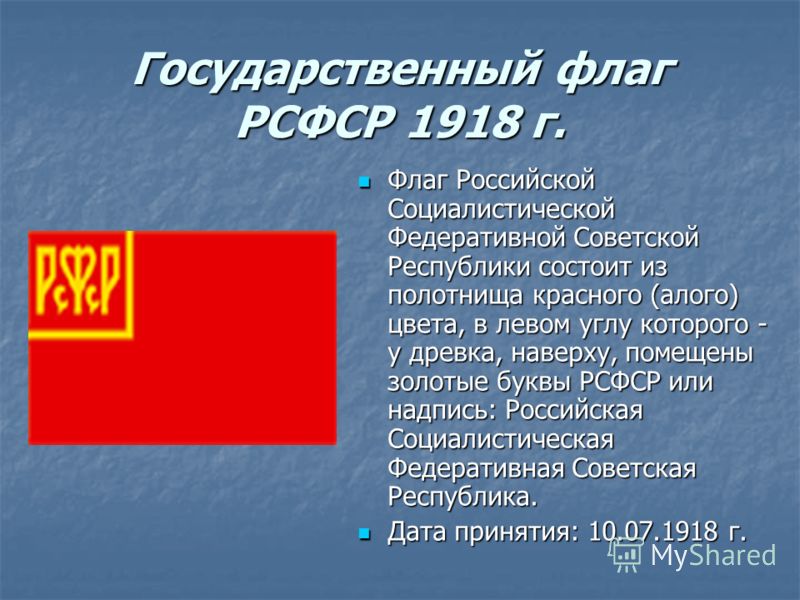
The national flag of Russia The national flag of the Russian Federation is a rectangular panel of three equally-sized horizontal stripes: the top is white, the middle is blue, and the bottom is red. The national flag of the Russian Federation is a rectangular panel of three equal horizontal stripes: the top is white, the middle is blue, and the bottom is red. The colors of the flag of Russia denote: white is peace, purity, purity, perfection; blue is the color of faith and loyalty, constancy; Red color symbolizes energy, force, blood, shed for the Fatherland. The colors of the flag of Russia denote: white is peace, purity, purity, perfection; blue is the color of faith and loyalty, constancy; Red color symbolizes energy, force, blood, shed for the Fatherland. Date of adoption: (Act). Date of adoption: (Act).


 Live journal
Live journal Facebook
Facebook Twitter
Twitter